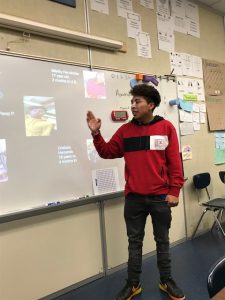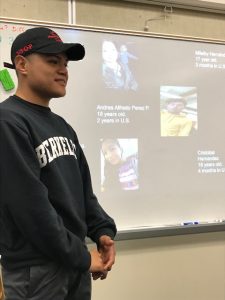Students Teach that Culture Means Community at Oakland International High School Community Walks
By Martha Sessums, President, ACE
Sometimes you have to flip things to understand them better.
That’s what Oakland International High School (OIHS) does during their annual Community Walk. The classroom is flipped. It’s the students who teach the teachers along with other educators and visitors.
The purpose is for the adults in the room to listen to the students tell their various stories and perspectives about their background and cultures. For a day, students are the ones in charge. Not only are their stories about food, language, dress, dance and other traditions told, but stories are shared about challenges as new immigrants. It’s about learning a language. Navigating the legal system. Figuring out BART and other transportation options. Learning math. Understanding homework. Learning to read in English and one’s traditional language, and sometimes a third language to navigate all the paths. Making friends that understand and support. And figuring out what’s the value of high school? The value of college? And importantly, what’s their value to me?
All this flipped listening and learning makes a difference according to Lauren Markham, Community School Program Manager.
“Community walks are a beloved tradition in our community,” Markham said. “They invert the teacher-student relationship and encourage deeper listening as students and community members narrate their stories, share their perspectives and discuss what they need from us as educators.”

Yosely Ordonez-Gomez (L) and Mileiby Hernandez Aguilar explain the color and style of traditional clothes.
I attended the Guatemalan Community Walk at OIHS recently and learned how to say “hello, good morning” in the indigenous Mam language (Jey B’an jun Xie te teya) which is a Mayan language spoken by about half a million people in Guatemala. I also learned that when Spain defeated the Aztec Empire in 1521 and invaded Guatemala in 1524, they replaced the indigenous languages (there are 30 dialects in Mam alone) with Spanish. So, some students speak Spanish only, some speak Mam only and some both.
According to the Guatemalan Student Leaders, one of their challenges is to speak English. They demonstrated the difficulty using phrases in Mam to try to understand and speak. Their language uses mouth movements and sounds that are foreign to me, just as English has movements and pronunciations they’re not used to. And each dialect spoken is different.
I’m a forever French language student so I understand language differences. But this was amazing. Four letters in Mam can be pronounced in three syllables – and half of those are in the back of the mouth. Language can be a big barrier and OIHS does a great job with the students and their parents to help them learn with a variety of techniques from Survival English as well as a positive school culture that supports all learners.
One of the ACE Learning Centers is at OIHS and focuses on providing English language classes for all parents. Teachers are from Refugee & Immigrant Transitions and parents learn survival English to figure out transportation, immigration issues, understand their rights, get and keep jobs and a host of other things. OIHS even has a garden where parent students grow favorite herbs and vegetables and have days where they share traditional cooking.
Back to the Guatemalan classroom. We also learned about traditional clothes and that the color and style depend on the clan. Then we learned how to dance a favorite traditional dance with a one-two-three movement and a raised knee on the third step. I learned the technique from Christobal Hernandez Velasquez, one of the student leaders, and even got into the rhythm to turn a circle doing the three-step with him. He speaks Spanish, not Mam, but he sure dances Mam.
Our group then took BART to Laney College’s Latinex Cultural Center where we met the staff that supports the Latino community, including Guatemalan. The Center teaches Mam, but also helps students work out their personal education plans at Laney by helping students succeed in language and classes so they can finish Laney in two years and move on to a four-year college.
One of the Latinex Mam Instructors was Henry Sales who is an OIHS graduate. He also works at the US/Mexico border to interpret for those held by US Customs and Border Protection. With 30 Mam dialects, he can’t always help, but he is often there helping Mam speakers understand what is being asked of them and asking questions for them.
“They see me as hope, but I just interpret,” Sales said.
The Community Walk was over, and my interpretation was that these students are brave, strong, dedicated, curious and smart. They face more challenges in one day than many in the US face in a month. These Guatemalan students bring a lot to their classroom and to our country.
At OIHS, culture has a default meaning. Culture means community. Students teach, teachers learn and vice versa. The Community Walks help illustrate that definition of culture.
And how to dance in Guatemala. One-two-three, knee up.


